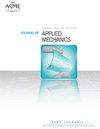定制二维纳米材料增强陶瓷基复合材料的增韧效果
IF 2.8
4区 工程技术
Q2 MECHANICS
引用次数: 0
摘要
由二维(2D)纳米材料增强的陶瓷基复合材料(CMC)显示出非凡的承载能力,即使在新兴应用所需的恶劣环境中也是如此。其优异的机械性能,尤其是断裂韧性,主要源于其不均匀的微观结构。2D增强材料的有意分散使得增韧机制成为基体的外在机制,从而赋予复合材料对灾难性失效的实质抵抗力。然而,对这种纳米复合材料的断裂行为,特别是基体/增强界面的复杂能量耗散过程的不完全理解,限制了更强、更硬CMC的发展。为了克服这些限制,我们使用扩展的内聚剪切滞后模型研究了纳米复合材料中的裂纹偏转和能量耗散。这一新模型考虑了界面脱粘和摩擦,它们对纳米复合材料的增韧起着关键控制作用。我们的分析为优化CMC的增韧效果提供了机理上的见解。本文章由计算机程序翻译,如有差异,请以英文原文为准。
Tailoring the toughening effects in two-dimensional nanomaterial-reinforced ceramic matrix composites
Ceramic matrix composites (CMCs) reinforced by two-dimensional (2D) nanomaterials have shown extraordinary load-carrying capacities, even in the harsh environments required by emerging applications. Their exceptional mechanical performance, especially fracture toughness, primarily arises from their heterogeneous microstructures. The deliberate dispersion of 2D reinforcements enables toughening mechanisms that are extrinsic to the matrix and thus endows the composites with substantial resistance to catastrophic failure. However, the incomplete understanding of the fracture behavior of such nanocomposites, especially the complex energy dissipation process of the matrix/reinforcement interface, limits the development of stronger and tougher CMCs. To overcome these limitations, we investigate crack deflection and energy dissipation in nanocomposites using an extended cohesive shear-lag model. This new model accounts for interfacial debonding and friction, which critically control the toughening of nanocomposites. Our analysis provides mechanistic insights for optimizing the toughening effects of CMCs.
求助全文
通过发布文献求助,成功后即可免费获取论文全文。
去求助
来源期刊
CiteScore
4.80
自引率
3.80%
发文量
95
审稿时长
5.8 months
期刊介绍:
All areas of theoretical and applied mechanics including, but not limited to: Aerodynamics; Aeroelasticity; Biomechanics; Boundary layers; Composite materials; Computational mechanics; Constitutive modeling of materials; Dynamics; Elasticity; Experimental mechanics; Flow and fracture; Heat transport in fluid flows; Hydraulics; Impact; Internal flow; Mechanical properties of materials; Mechanics of shocks; Micromechanics; Nanomechanics; Plasticity; Stress analysis; Structures; Thermodynamics of materials and in flowing fluids; Thermo-mechanics; Turbulence; Vibration; Wave propagation

 求助内容:
求助内容: 应助结果提醒方式:
应助结果提醒方式:


